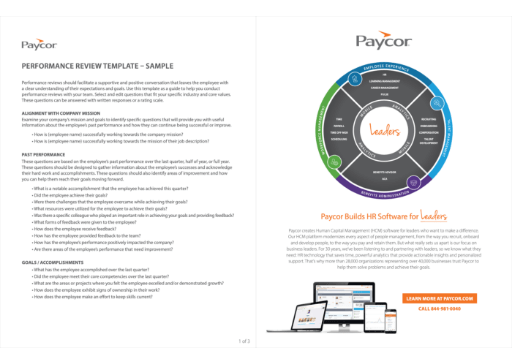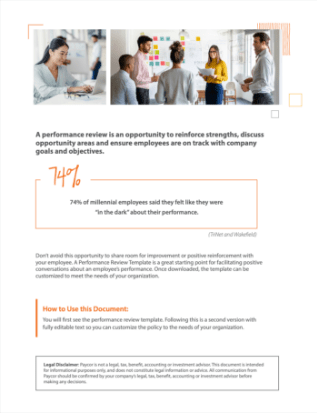Get Our Customizable Review Template
It’s natural to want to avoid the dreaded performance review (neither employees nor employers enjoy it) but there’s a ton of evidence on why you shouldn’t. 82% of workers surveyed say they feel valued when someone takes time to provide feedback and 79% of workers say feedback is important to their professional development (Eagle Hill Consulting). Feedback, when delivered appropriately, can boost engagement, retention and help employees see how their everyday actions influence your organization’s objectives and key results (OKRs). Some of the most widely shared advice about performance management encourages leaders to create a culture of continuous feedback and request meetings frequently.
However, if you’re new to this or not sure how to create or revise your job performance review process, we’ve prepared a Performance Review Template and a list of helpful tips you can use to get started.
What should be included in a performance review?
A performance review, or performance evaluation, is an opportunity to reinforce strengths, discuss opportunity areas and ensure employees are on track with company goals and objectives. Each session should be customized to fit your work environment and your employees’ specific functions. Here are a few basic components that should
- Employee information, which includes a basic review of an employee’s job description, current duties and goals.
- Evaluation criteria and timeline for review period. Be sure to share the specifics around how the employee’s performance will be measured, it should never be a surprise; and the time frame of when their performance will be measured.
- Feedback — an employee should have an opportunity to share feedback about the work experience. This is also their chance to review their performance as well.
Below are a few more common components of a performance review process.
Company Alignment
Many companies have core values or a communicated vision and mission that guide the organization. A good way to start a performance review is by checking in on the employee’s understanding of and alignment with the company’s guiding principles. Employees benefit from knowing how their role affects larger company initiatives.
Past Performance
This is the part most employers commonly cover in performance reviews. An assessment of an employee’s past performance usually includes a discussion about how this person can improve or how the performance has benefited the company. One of the benefits of conducting more frequent reviews is that they provide more opportunities for improvement or positive reinforcement.
Accomplishments
You’ve got to celebrate the wins. No employee wants to spend an hour or 90 minutes talking about everything they’ve done wrong in the past year or 6 months. Talk about everything the employee has accomplished in the time period and how those same behaviors can be duplicated.
Goals
Checking in on goals from the past evaluation period is critical. But, this is also where a more frequent check-in will help with accountability. Additionally, this is a great time to help your employee set goals for the future. Does your employee know what they’d like to do next? When employees have a defined career path, it can also boost retention and engagement.
Manager Relationship
It’s very important for your employee to feel heard. A review is a great time for you to provide employees with an opportunity to discuss your relationship and whether or not it is working or how it could be improved. Structured questions that your employee answers in advance will help guide the conversation.
What should not be included in a performance review?
When conducting a performance review, an employer should steer clear of any comments based on the employee’s race, gender, age, religion, or any other personal characteristics. They should also avoid making vague or generalized statements about the employee’s performance without providing specific examples. Employers should refrain from comparing the employee to peers and not use the review as an opportunity to micromanage or criticize the employee’s work without providing constructive feedback on how they can improve.
How to conduct a performance review
One common performance review best practice is to share the questions with your employee in advance within an employee evaluation template, ask them to write responses privately while you write your answers about them on your own, and then the two of you can meet to review the answers together. Creating an employee performance review checklist can also help you plan the meeting. Select the questions most relevant to your team and your employee’s function and plan a structured discussion. Afterward, scheduling a follow-up meeting to review goals is a great way to keep your employee on track. However, if you are regularly meeting in weekly or monthly 1-on-1s, you can touch base on tasks, goals and assignments in those meetings. You will want to ensure you are having a two-way conversation, providing space for your employee to evaluate you as a leader and request that employees also evaluate themselves.
Tips for an effective performance review
Remember, your ability to motivate your employee during this performance evaluation time relies on your strategic language and approach.
Make it a Two-Way Conversation
Ensure your employee has a chance to tell their own story about their performance and listen intently to their side. It may also be helpful in some cases to have peer reviews. With a little constructive feedback, opportunity areas in one performance review can turn into big wins in future performance reviews.
Be a Coach
By taking a role of a coach, and not just a manager, you can help motivate and encourage your direct report to reach their full potential. Ensure you are clear on your employee’s career goals for professional development so you can help the employee to reach them.
Provide Actionable Feedback
Additionally, make sure you have clear, well-documented steps to help your employee move forward after the review. With the right approach, you can help them feel confident and empowered to take their performance to the next level.
How Paycor Helps
Consider the impact of a talent development and performance management program instead of annual performance reviews that only measure the effectiveness of past performance. As you think about how to improve your performance review process, discover how using technology could help you keep track of weekly or monthly meetings as well as recognition and goals. Paycor Talent Development moves beyond the annual performance review by allowing you to create a culture of continuous development. It is designed to help you manage 1-on-1s, quarterly performance reviews, team recognition and more. When you give your team continuous feedback, you also give your team the opportunity to grow and develop. You also improve outcomes and enhance engagement. Get a head start on performance reviews by using our free customizable template.











